初中英语简单句精讲精练
「中考英语」“简单句”六大考点,专项讲解及练习(配答案)
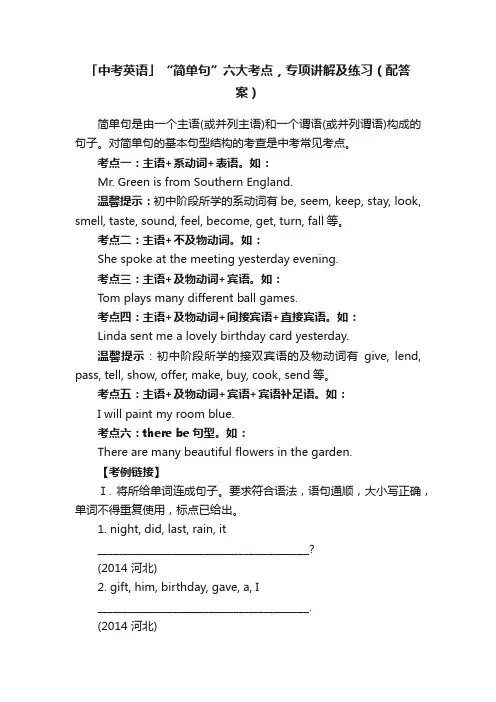
「中考英语」“简单句”六大考点,专项讲解及练习(配答案)简单句是由一个主语(或并列主语)和一个谓语(或并列谓语)构成的句子。
对简单句的基本句型结构的考查是中考常见考点。
考点一:主语+系动词+表语。
如:Mr. Green is from Southern England.温馨提示:初中阶段所学的系动词有be, seem, keep, stay, look, smell, taste, sound, feel, become, get, turn, fall等。
考点二:主语+不及物动词。
如:She spoke at the meeting yesterday evening.考点三:主语+及物动词+宾语。
如:Tom plays many different ball games.考点四:主语+及物动词+间接宾语+直接宾语。
如:Linda sent me a lovely birthday card yesterday.温馨提示:初中阶段所学的接双宾语的及物动词有give, lend, pass, tell, show, offer, make, buy, cook, send等。
考点五:主语+及物动词+宾语+宾语补足语。
如:I will paint my room blue.考点六:there be句型。
如:There are many beautiful flowers in the garden.【考例链接】Ⅰ. 将所给单词连成句子。
要求符合语法,语句通顺,大小写正确,单词不得重复使用,标点已给出。
1. night, did, last, rain, it__________________________________________?(2014 河北)2. gift, him, birthday, gave, a, I__________________________________________.(2014 河北)3. tennis, a, Nancy, twice, week, play__________________________________________.(2014 河北)Ⅱ. 将下列汉语翻译成英语。
最新英语简单句、并列句和复合句精讲精练
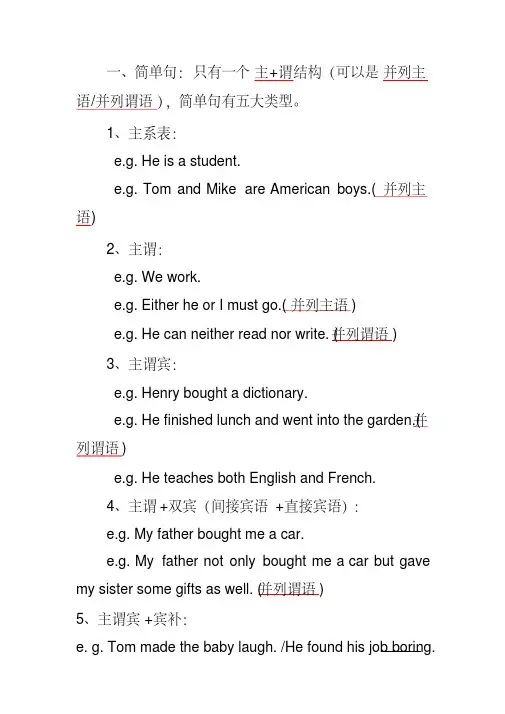
一、简单句:只有一个主+谓结构(可以是并列主语/并列谓语),简单句有五大类型。
1、主系表:e.g. He is a student.e.g. Tom and Mike are American boys.(并列主语)2、主谓:e.g. We work.e.g. Either he or I must go.(并列主语)e.g. He can neither read nor write. (并列谓语)3、主谓宾:e.g. Henry bought a dictionary.e.g. He finished lunch and went into the garden.(并列谓语)e.g. He teaches both English and French.4、主谓+双宾(间接宾语+直接宾语):e.g. My father bought me a car.e.g. My father not only bought me a car but gave my sister some gifts as well. (并列谓语)5、主谓宾+宾补:e. g. Tom made the baby laugh. /He found his job boring.二、并列句:由2个主+谓结构,即由两个并列而又独立的简单句构成。
常用并列连词(and, but, or等)或分号(;)连接。
e. g. You help him and he helps you.The future is bright; the road is tortuous.详见新概念L25课。
三、复合句:由2个主+谓结构,其中一个句子叫主句,另一个叫从句。
主句为句子的主体, 从句只用作句子的一个次要成分,不能独立成为一个句子。
从句通常由从属连词引导,并由从属连词将从句和主句联系在一起。
从句按其在复合句中的作用,分为主语从句、表语从句、宾语从句、同位语、定语从句和状语从句等。
简单句的基本句型讲解(附练习题+答案)
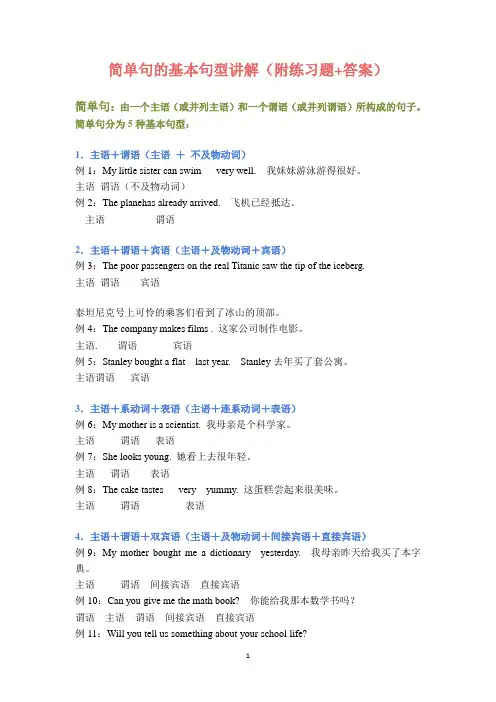
简单句的基本句型讲解(附练习题+答案)简单句:由一个主语(或并列主语)和一个谓语(或并列谓语)所构成的句子。
简单句分为5种基本句型:1.主语+谓语(主语+不及物动词)例1:My little sister can swim very well. 我妹妹游泳游得很好。
主语谓语(不及物动词)例2:The planehas already arrived. 飞机已经抵达。
主语谓语2.主语+谓语+宾语(主语+及物动词+宾语)例3:The poor passengers on the real Titanic saw the tip of the iceberg.主语谓语宾语泰坦尼克号上可怜的乘客们看到了冰山的顶部。
例4:The company makes films . 这家公司制作电影。
主语. 谓语宾语例5:Stanley bought a flat last year. Stanley去年买了套公寓。
主语谓语宾语3.主语+系动词+表语(主语+连系动词+表语)例6:My mother is a scientist. 我母亲是个科学家。
主语谓语表语例7:She looks young. 她看上去很年轻。
主语谓语表语例8:The cake tastes very yummy. 这蛋糕尝起来很美味。
主语谓语表语4.主语+谓语+双宾语(主语+及物动词+间接宾语+直接宾语)例9:My mother bought me a dictionary yesterday. 我母亲昨天给我买了本字典。
主语谓语间接宾语直接宾语例10:Can you give me the math book? 你能给我那本数学书吗?谓语主语谓语间接宾语直接宾语例11:Will you tell us something about your school life?谓语主语谓语间接宾语直接宾语你给我讲讲你们的学习生活,好吗?5.主语+谓语+复合宾语(主语+及物动词+宾语+补语)例12:We must keep our classroom clean and tidy. 我们必须保持教室干净、整洁。
九年级英语_专题13 简单句考点聚焦和精讲(解析版)
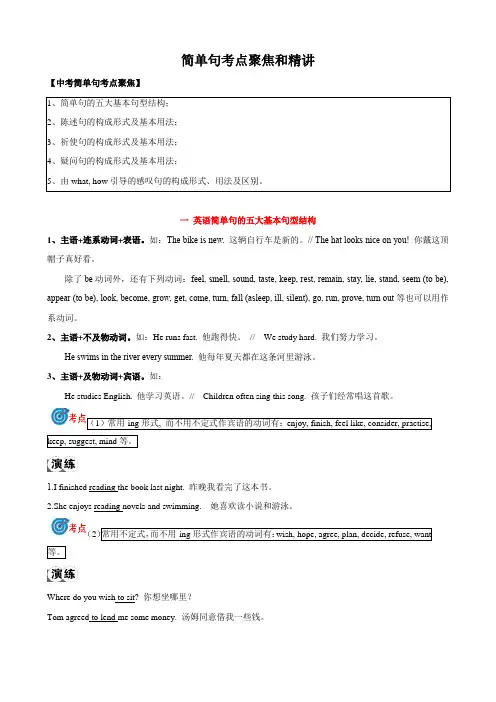
简单句考点聚焦和精讲【中考简单句考点聚焦】一英语简单句的五大基本句型结构1、主语+连系动词+表语。
如:The bike is new. 这辆自行车是新的。
// The hat looks nice on you! 你戴这顶帽子真好看。
除了be动词外,还有下列动词:feel, smell, sound, taste, keep, rest, remain, stay, lie, stand, seem (to be), appear (to be), look, become, grow, get, come, turn, fall (asleep, ill, silent), go, run, prove, turn out等也可以用作系动词。
2、主语+不及物动词。
如:He runs fast. 他跑得快。
// We study hard. 我们努力学习。
He swims in the river every summer. 他每年夏天都在这条河里游泳。
3、主语+及物动词+宾语。
如:He studies English. 他学习英语。
// Children often sing this song. 孩子们经常唱这首歌。
(1)常用-ing形式, 而不用不定式作宾语的动词有:enjoy, finish, feel like, consider, practise, keep, suggest, mind等。
1.I finished reading the book last night. 昨晚我看完了这本书。
2.She enjoys reading novels and swimming. 她喜欢读小说和游泳。
(2)常用不定式,而不用-ing形式作宾语的动词有:wish, hope, agree, plan, decide, refuse, want等。
Where do you wish to sit? 你想坐哪里?Tom agreed to lend me some money. 汤姆同意借我一些钱。
初中简单句精讲及精练
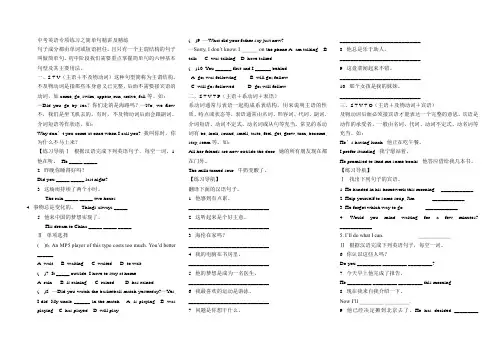
中考英语专项练习之简单句精讲及精练句子成分都由单词或短语担任,且只有一个主谓结构的句子叫做简单句。
初中阶段我们需要重点掌握简单句的六种基本句型及其主要用法。
一、S + V(主语+不及物动词)这种句型简称为主谓结构。
不及物动词是指那些本身意义已完整,后面不需要接宾语的动词,如come, go, swim, appear, run, arrive, fall等。
如:—Did you go by sea?你们走的是海路吗?—No, we flew.不,我们是坐飞机去的。
有时,不及物动词后面会跟副词、介词短语等作状语。
如:Why don’t you come at once when I call you? 我叫你时,你为什么不马上来?【练习导航Ⅰ. 根据汉语完成下列英语句子,每空一词。
1.他在听。
He _____ _____.2. 昨晚你睡得好吗?Did you _____ _____ last night?3. 这场雨持续了两个小时。
The rain _____ _____ two hours.4. 事物总是变化的。
Things always _____.5. 他来中国的梦想实现了。
His dream to China _____ _____ _____.Ⅱ. 单项选择( )6. An MP5 player of this type costs too much. Y ou’d better ______.A. waitB. waitingC. waitedD. to wait( )7. It _____ outside. I have to stay at home.A. rainB. is rainingC. rainedD. has rained( )8. —Did you watch the basketball match yesterday?—Y es,I did. My uncle ______ in the match. A. is playing B. wasplaying C. has played D. will play ( )9. —What did your father say just now?—Sorry, I don’t know. I ______ on t he phone.A. am talking B.talk C. was talking D. have talked( )10. Y ou ______ first and I ______ behind.A. go; was followingB. will go; followC. will go; followedD. go; will follow二、S + V + P(主语+系动词+表语)系动词通常与表语一起构成系表结构,用来说明主语的性质、特点或状态等。
语法复习-简单句—初中英语课件ppt
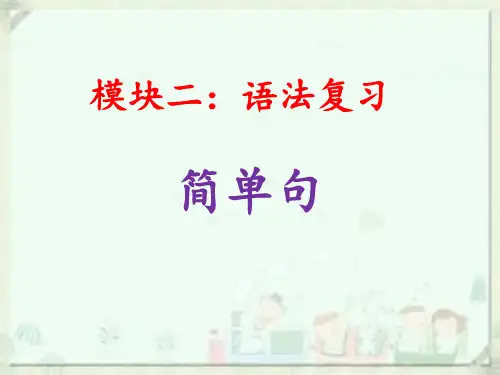
A. is
B. are
C. was
D. were
(A
) 3. There _________ a temple at the top of the
mountain long long ago.
A. used to be
B. will be
C. were
D. is
( B ) 4. —_________ there any flowers in your garden?
桌面上有一本书和两支笔。
考点精讲精练
There are (were) two pens and a book on the desk. (two pens与be动词最近,故用are / were)
桌面上有两支笔和一本书。 There used to be a big house in front of the mountain. 在山的前面曾经有一座大屋。 There will be more trees in the garden in a short time. 很快这个花园就会有更多的树。
A. Never
B. Not
C. Doesn’t
D. No
(B
) 3. _________ me a message on WeChat before
you come to Guangzhou. I will meet you at the
airport.
A. Don’t send
B. Send
C. Sending
考点精讲精练
Anna wasn’t writing a letter at 8:00 last night, was she? 安娜昨晚8点时不在写信,是不是? (前句助动词是wasn’t (be), 后句用相应的was) You often go to the park to take a walk, don’t you? 你常常去公园散步,是不是? (前句动词是go(实义动词),后句用相应的don’t)
冀教版八年级英语语法简单句精讲精练
冀教版八年级英语语法简单句精讲精练1简单句的六种基本句型1.“主语+ 谓语”(即“主谓”句型)例:They arrived in Harbin yesterday morning.分析:“they”(主语)“arrived”(谓语)。
2.“主语+ 谓语+ 宾语”(即“主谓宾”句型)例:I study English.分析:“I”(主语)“study”(谓语动作)“English”(宾语即动作涉及的对象)。
3.“主语+ 谓语+ 间接宾语+ 直接宾语”(即“主谓双宾”句型)例:Our teacher taught us English.分析:“our teacher”(主语)“教”(谓语动作)“us”(间接宾语)“English”(直接宾语)。
4.“主语+ 谓语+ 宾语+ 宾语补足语”(即“主谓宾宾补”句型)例:He asked her to go there.分析:“he”(主语)“asked”(谓语动作)“her”(宾语即动作涉及的对象)“to go there”(补语—补说明宾语做什么)。
5.“主语+ 系动词+ 表语”(即“主系表”句型)常用的系动词有be, keep,lie, remain, stand, become, fall, get, go, grow, turn, look, feel, seem, smell, sound, taste, 等。
例:I am a teacher. 我是一名老师分析:“I”(主语)“am”(系动词)“a teacher”(表语—即表明主语的身份)。
6.there be 句型本句型表示人或事物“存在”的概念,常译为“某地有某物”。
此句型应注意以下两点: (1)就近原则,即be动词要与离它较近的主语保持一致。
如果是单个的主语,动词be则随这个主语的数和人称而变化。
如果是并列的主语,动词be一般随最靠近它的那个主语的人称和数而变化。
There is a dictionary on the desk. 书桌上有一本字典。
中考简单句精讲精练
中考简单句精讲精练预测2015年中考专题考点:1.陈述句中日常交际用语2. 祈使句的构成3. 由what/how引导的感叹句4. 反意疑问句的用法及回答5. 特殊疑问句的疑问词的选择一、陈述句1. 肯定句与否定句:too…to等词,也构成否定句。
I never smoke. He has no sisters. There is few students in the classroom.I seldom go to hospital. He came too late to catch the bus.1)Some of us have finished it already.(变否定句)2)I told somebody something.(变否定句)3)I can understand both of these two questions. (变否定句)2.so/neither倒装句:A. Sb. do so. “某某这样做了。
”So sb. do…“某某的确如此”So do sb. “某某也是如此”1)---He looks so cool on that suit! --- _______________________(的确如此)2)Mother told him stay at home. __________________(他这样做了)3)---I like salad best. ---- _____________________(我也是如此)4)-- I hear Tom made an English speech at the graduation ceremony yesterday.-- ___________ and ____________.A. So he did; so did IB. So did he; so I did.C. So he was; so I wasD. So was he; so I wasB.“肯定句,so+情态动词/助动词/be动词+主语” “表示前面提到的肯定的内容也适用于后者”,否定句,Nor/neither+情态动词/助动词/be动词+主语“表示前面提到的否定的内容也适用于后者”1) ---I didn’t see the film last night. ---__________________(我也是如此)2)She has been to New York and ____________________( 我也是如此)3) ---My room is very cold. --- ____________________________________(我的也是如此)4)---Mike can draw cartoons and _____________________________(他弟弟也会)5)If Joe’s wife doesn’t go to the party, _______________________(他也不去)【中考演练】(11湖北黄冈)---My brother and I will go to the library tomorrow. ---________. Shall we go together?A. So I doB. So do IC. So will ID. So I will(13新疆) ---I never drink coffee. ---___________.A. So do IB. So did IC. Neither did ID. Neither do I(13广东模拟)---David and his classmates went for a picnic yesterday afternoon. ---___________.A. So did theyB. So they didC. So were theyD. So they were(12梅州模拟) --- It’s burning hot today, isn’t it? ---Yes. _____________ yesterday.A. So was itB. So it wasC. So it isD. So is it3.so和not可以用来代替上文中出现过的句子的一部分或整个分句,以免重复。
中考必备--简单句专讲专练
中考必备--简单句专讲专练简单句是由一个主语(或并列主语)和一个谓语(或并列谓语)构成的句子。
对简单句的基本句型结构的考查是中考常见考点。
考点一:主语+系动词+表语。
如:She is a middle school teacher.温馨提示:初中阶段所学的系动词有be, seem, keep, stay, look, smell, taste, sound, feel, become, get, turn, fall等。
考点二:主语+不及物动词。
如:The children skated on the frozen river.考点三:主语+及物动词+宾语。
如:They’re building a new bridge over the river.考点四:主语+及物动词+间接宾语+直接宾语。
如:The children proudly showed me their presents.考点五:主语+及物动词+宾语+宾语补足语。
如:John asked me to have dinner with him.考点六:there be句型。
该句型结构为“There be +主语+ 地点状语 / 时间状语”。
该句型有各种时态的变化,其一般将来时结构为“There will be +主语 + ...”或“There is / are going to be +主语+ ...”。
【考例链接】Ⅰ. 连词成句1. we, happy, sang, on the way______________________. (2015河北)2. picture, is, the, new, three______________________. (2016河北)3. it, I, yesterday, draw______________________. (2016河北)Ⅱ. 汉译英1. 他发现自己的房间乱七八糟。
初中英语中考复习简单句专项练习(附参考答案解析和知识点讲解)
中考英语简单句专项练习班级考号姓名总分一、选择1.—will they finish printing the newspaper?—In five hours.A.How muchB.How oftenC.How soonD.How long2.—Kate won first prize in the singing competition.—pleasant surprise this gave her classmates!A.What aB.HowC.WhatD.How a3. exciting it is! Our country launched her first home-made aircraft carrier(国产航空母舰)on April 26 in Dalian.A.HowB.WhatC.How anD.What an4.—Mom, can I go dancing this evening?—your homework first, and then we’ll talk about it.A.FinishB.FinishingC.To finishD.Finished5.—can you finish your homework?—In about one and a half hours.A.How fastB.How soonC.How oftenD.How long6.—exciting movies they are!—I agree with you. I also like them very much.A.WhatB.What anC.HowD.How an二、连词成句(一)1.in, is, room, who, the2.grow, here, nothing, well, can3.good, brought, you, news, what, us4.will, two, tomorrow, there, meetings, bee, the, se e, in, didn’t, teacher, you(二)1.like, you, do, the sweater2.friend, best, is, who, your3.books, often, she, in the morning, reads4.enjoy, to, try, life, your5.rides, he, how, the, fast, bike(三)1.next week, will, TV, he, watch2.afraid of, Li Gang, talking to, is, strangers3.him, way, to, happened, on, what, the4.too much, in the street, snow, there is5.interesting, it, what, an, is, collection(四)1.a, is, what, nice, he, man2.right, have, answer, found out, the, you3.to, it’s, sho p, cheaper, online, much4.is, your, car, man, who, the, beside5.nothing, leg, there, wrong, is, her, with(五)1.bags, these, yours, are2.for, be, don’t, class, late3.want, do, you, what, be, to4.have, to, needs, she, a, rest, good5.the, a, from, library, book, I, yesterday, borrowed(六)1.you,seen,giraffes,have2.the,they,tallest,are,animals3.to,they,us,friendly,are4.eat,usually,leaves,they,green5.me,can,make friends with,they附:参考答案一、选择1.【答案】C【解析】句意:——他们多久之后将印完这些报纸?——五小时后。
- 1、下载文档前请自行甄别文档内容的完整性,平台不提供额外的编辑、内容补充、找答案等附加服务。
- 2、"仅部分预览"的文档,不可在线预览部分如存在完整性等问题,可反馈申请退款(可完整预览的文档不适用该条件!)。
- 3、如文档侵犯您的权益,请联系客服反馈,我们会尽快为您处理(人工客服工作时间:9:00-18:30)。
简单句作为中考的考点,具体内容包含了祈使句、感叹句、一般疑问句、特殊疑 问句、选择疑问句、反意疑问句、倒装句及主谓一致。 考点一 祈使句 1.肯定祈使句 ①句型:动词原形+其他成分。 如:Be careful!小心! ②“Do+祈使句”表示一种强烈的感情或请求,do起强调作用。 ③please用在祈使句中表示一种客气的语气,但用在句末时,必须用逗号与其余部 分隔开。 如:Close the door,please.请关门!
How+主语+谓语!
How+形容词/副词(+主语+谓 语)!
How+形容词+a/an+单数可数 名词(+主语+谓语)!
例句
用法
What a kind girl (she is)!多好的女孩啊!
What beautiful flowers (they are)!多
漂亮的花啊! What bad weather (it is)!多糟糕的天气啊
!
How time flies!时间 飞逝!
How brave (the hero is)!多伟大的英雄啊
!
How clever (a boy he is)!多聪明的男孩啊
!
感叹句,ow与形 、副紧相 连。为了 使句子更 简洁,主 谓部分也 可省。
⑥掌握“祈使句+and/or+结果状语”结构。如: Work harder,and you'll get good grades.更加努力吧,你会取得好成绩的。
类别 what引导
how引导
结构 What + a/an+形容词+单数可
数名词(+主语+谓语)!
What+形容词+复数可数名词/ 不可数名词(+主语+谓语)!
考点四 倒装句 英语句子的自然语序是主语在前,谓语动词在后。如果把谓语动词放在主语之 前,就构成了倒装句。下面是几种倒装句的具体形式: 1.so/neither+助动词/be动词/情态动词+主语 该结构常用来说明前面所说的情况也同样适用于后面的人或物,其中的助动词 /be动词/情态动词在形式上与前句的谓语保持一致,而其单复数形式则由后句 的主语决定。但“so+倒装”依附于肯定句,表示前边肯定的情况也适合后边 的人(物),意为“……也……”。“neither+倒装”依附于否定句,表示前边 否定的情况也适合后边的人(物),意为“……也不……”。如:
考点三 疑问句 1.一般疑问句 结构为:①Be+主语+其他; ②助动词(或情态动词)+主语+谓语(动词原形)+其他。 肯定回答:Yes,主语+be/助动词/情态动词; 否定回答:No,主语+be/助动词/情态动词+not。(not一般要与前面的动词构 成缩略形式。)
【注意】 ❶情态动词must提问时,否定回答用needn't或don't have to。如: —Must I go now?我必须现在去吗? —Yes,you must./No,you needn't.是的,你必须去。/不,不必。 ❷否定的一般疑问句通常是以be动词、情态动词或助动词与not的缩略形式开头 ,往往表示惊讶、赞叹、怀疑等语气。注意Yes和No在翻译成中文时与其原意 正好相反。如: —Don't you hear of that?难道你没听说过那件事?(表示惊讶) —Yes,I do./No,I don't.不,我听说过。/是的,我没听说过。
词组 how many how much how often how long how soon
how far
含义 多少 多少(钱) 多久一次 多长时间 多久 多远
用法
提问数量,后跟可数名词复数 ①提问数量,后跟不可数名词;
②提问价格 提问频率 提问持续的时间,答语用“for+一段时间 ”或“since+过去的时间点” 提问将来的时间,答语用“in+一段时间” 提问距离
3.选择疑问句 提出两种或两种以上的情况,要求对方作出选择回答的问句叫选择疑问句。选 择疑问句中两种或两种以上的情况用or连接,回答时不能用Yes或No,要用一 个完整的句子或其省略形式。选择疑问句分为一般选择疑问句和特殊选择疑问 句两种。 ①一般选择疑问句:一般疑问句+or+被选择部分?如: —Do you like apples or pears?你喜欢苹果还是梨? —I like pears.我喜欢梨。 ②特殊选择疑问句:特殊疑问句+A or B?如: —Which would you like better,tea or coffee?茶和咖啡,你更想要哪一种? —I'd like coffee.我想要咖啡。
2.否定祈使句 ①常见句型:Don't+动词原形+其他成分。 如:Don't be late for school again!别再迟到了! ②以Never开头:Never+动词原形+其他成分。 如:Never leave today's work for tomorrow!不要把今天的工作留到明天! ③No+名词/动名词 如:No photos!禁止照相! ④Don't let+动词原形=Let's not+动词原形 如:Don't let him go there alone.=Let him not go there alone. ⑤回答祈使句时要用将来时。如: —Please remember to walk the dog every day.请记住每天去遛狗。 —Yes,I will.是的,我会的。
2.特殊疑问句 由疑问词引导的疑问句叫特殊疑问句。特殊疑问句应针对所提的问题进行具体 回答,不能用Yes或No回答。结构:疑问代词或疑问副词+一般疑问句? 常见的疑问代词有:who,whom,what,which,whose等;疑问副词有:when ,where,how,why等;由what和how构成的词组有what color,what time, how far,how old,how many,how often,how soon等。如: When did it start?它什么时候开始的? Where do they come from?他们来自哪里? Why do you like pandas?你为什么喜欢熊猫? What color is your schoolbag?你的书包是什么颜色的? How much is the Tshirt?这件T恤衫多少钱?
